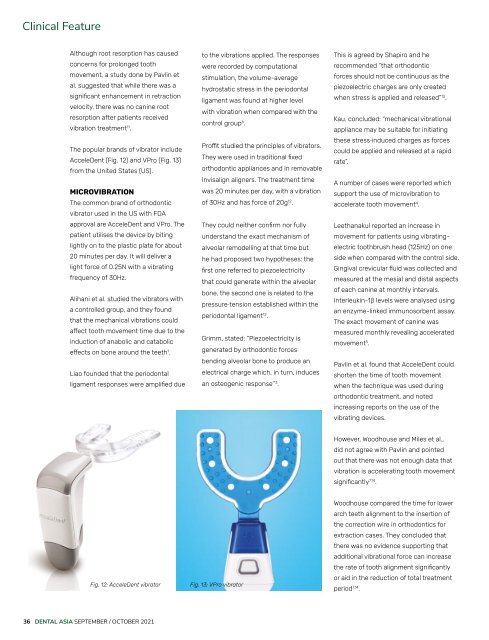Dental Asia September/October 2021
For more than two decades, Dental Asia is the premium journal in linking dental innovators and manufacturers to its rightful audience. We devote ourselves in showcasing the latest dental technology and share evidence-based clinical philosophies to serve as an educational platform to dental professionals. Our combined portfolio of print and digital media also allows us to reach a wider market and secure our position as the leading dental media in the Asia Pacific region while facilitating global interactions among our readers.
For more than two decades, Dental Asia is the premium journal in linking dental innovators and manufacturers to its rightful audience. We devote ourselves in showcasing the latest dental technology and share evidence-based clinical philosophies to serve as an educational platform to dental professionals. Our combined portfolio of print and digital media also allows us to reach a wider market and secure our position as the leading dental media in the Asia Pacific region while facilitating global interactions among our readers.
You also want an ePaper? Increase the reach of your titles
YUMPU automatically turns print PDFs into web optimized ePapers that Google loves.
Clinical Feature<br />
Although root resorption has caused<br />
concerns for prolonged tooth<br />
movement, a study done by Pavlin et<br />
al. suggested that while there was a<br />
significant enhancement in retraction<br />
velocity, there was no canine root<br />
resorption after patients received<br />
vibration treatment 11 .<br />
The popular brands of vibrator include<br />
AcceleDent (Fig. 12) and VPro (Fig. 13)<br />
from the United States (US).<br />
MICROVIBRATION<br />
The common brand of orthodontic<br />
vibrator used in the US with FDA<br />
approval are AcceleDent and VPro. The<br />
patient utilises the device by biting<br />
lightly on to the plastic plate for about<br />
20 minutes per day. It will deliver a<br />
light force of 0.25N with a vibrating<br />
frequency of 30Hz.<br />
Alihani et al. studied the vibrators with<br />
a controlled group, and they found<br />
that the mechanical vibrations could<br />
affect tooth movement time due to the<br />
induction of anabolic and catabolic<br />
effects on bone around the teeth 1 .<br />
Liao founded that the periodontal<br />
ligament responses were amplified due<br />
to the vibrations applied. The responses<br />
were recorded by computational<br />
stimulation, the volume-average<br />
hydrostatic stress in the periodontal<br />
ligament was found at higher level<br />
with vibration when compared with the<br />
control group 6 .<br />
Proffit studied the principles of vibrators.<br />
They were used in traditional fixed<br />
orthodontic appliances and in removable<br />
Invisalign aligners. The treatment time<br />
was 20 minutes per day, with a vibration<br />
of 30Hz and has force of 20g 12 .<br />
They could neither confirm nor fully<br />
understand the exact mechanism of<br />
alveolar remodelling at that time but<br />
he had proposed two hypotheses: the<br />
first one referred to piezoelectricity<br />
that could generate within the alveolar<br />
bone, the second one is related to the<br />
pressure‐tension established within the<br />
periodontal ligament 12 .<br />
Grimm, stated: “Piezoelectricity is<br />
generated by orthodontic forces<br />
bending alveolar bone to produce an<br />
electrical charge which, in turn, induces<br />
an osteogenic response’’ 3 .<br />
This is agreed by Shapiro and he<br />
recommended “that orthodontic<br />
forces should not be continuous as the<br />
piezoelectric charges are only created<br />
when stress is applied and released” 13 .<br />
Kau, concluded: “mechanical vibrational<br />
appliance may be suitable for initiating<br />
these stress‐induced charges as forces<br />
could be applied and released at a rapid<br />
rate”.<br />
A number of cases were reported which<br />
support the use of microvibration to<br />
accelerate tooth movement 4 .<br />
Leethanakul reported an increase in<br />
movement for patients using vibratingelectric<br />
toothbrush head (125Hz) on one<br />
side when compared with the control side.<br />
Gingival crevicular fluid was collected and<br />
measured at the mesial and distal aspects<br />
of each canine at monthly intervals.<br />
Interleukin-1β levels were analysed using<br />
an enzyme-linked immunosorbent assay.<br />
The exact movement of canine was<br />
measured monthly revealing accelerated<br />
movement 5 .<br />
Pavlin et al. found that AcceleDent could<br />
shorten the time of tooth movement<br />
when the technique was used during<br />
orthodontic treatment, and noted<br />
increasing reports on the use of the<br />
vibrating devices.<br />
However, Woodhouse and Miles et al.,<br />
did not agree with Pavlin and pointed<br />
out that there was not enough data that<br />
vibration is accelerating tooth movement<br />
significantly 7,14 .<br />
Fig. 12: AcceleDent vibrator<br />
Fig. 13: VPro vibrator<br />
Woodhouse compared the time for lower<br />
arch teeth alignment to the insertion of<br />
the correction wire in orthodontics for<br />
extraction cases. They concluded that<br />
there was no evidence supporting that<br />
additional vibrational force can increase<br />
the rate of tooth alignment significantly<br />
or aid in the reduction of total treatment<br />
period 7,14 .<br />
36<br />
DENTAL ASIA SEPTEMBER / OCTOBER <strong>2021</strong>


















